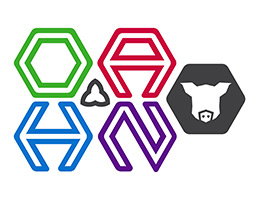Ontario Animal Health Network (OAHN) Swine Network Quarterly Veterinary Report
Novel Influenza A- H3N2 Cluster 2010.1
Dr. Hannah Golightly (OMAFRA) provided an overview of detections of Influenza A in swine from submissions received by the Animal Health Lab (AHL) during Q3. The distribution of Influenza A subtypes isolated has shifted markedly from Q3 2022 (graph a) to Q3 2023 (b). Graphs (c) and (d) below show the sequences of the influenza detections for the quarter split into those of H3N2 subtype, and all other subtypes isolated in Q3, respectively, and demonstrate the dominance of the novel H3N2 cluster 2010.1.
At the Ontario Association of Swine Veterinarians (OASV) fall conference in November, Dr. Kevin Vilaca (South West Ontario Veterinary Services) shared that this novel H3N2 strain has been added to a monovalent autogenous vaccine for producers at their clinic. He also confirmed that his veterinary practice is willing to share the protocol for CFIA emergency use and approvals with other veterinary clinics that would like to offer a monovalent autogenous vaccine to their clients. South West is also planning to include this novel influenza strain in their regional autogenous swine influenza vaccine pending CFIA approval, which is anticipated to be received in January 2024.
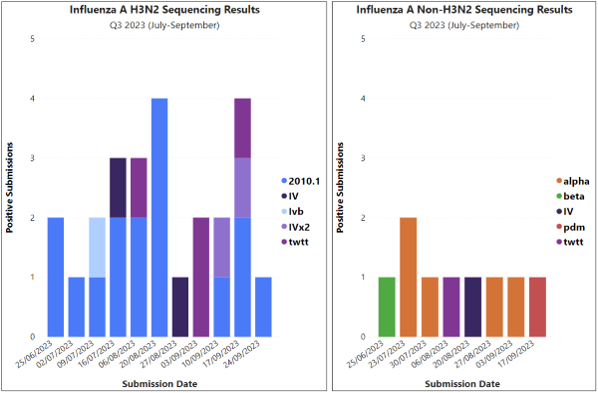
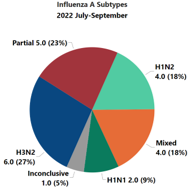
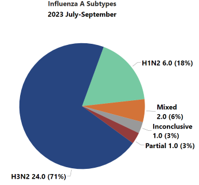
OMAFRA Swine Disease Dashboard
Dr. Hannah Golightly provided an overview of the OMAFRA Swine Disease Dashboard for Q3 2023:
Influenza A (IAV) Surveillance continued…
Dr. Golightly commented that in the influenza graphs presented (pg. 1), counts of unique submissions are being used so some of these detections may be repeat isolations from the same premises over time. In Q2 and Q3 2023 we observed a substantial increase in influenza activity compared to the years 2021 and 2022. In Q3 2023, the H3N2 subtype predominated with fewer H1N1 and H1N2 isolations compared to the last 2 years. Most of the influenza detections this quarter were from samples collected from nursery pigs, followed by samples from grow finish pigs, though herd type information was not always included on the lab submission forms.
Salmonella Surveillance
Dr. Golightly reminded us that the new level of analysis for Salmonella isolations is continuing in Q3. This new report differentiates between cases where Salmonella was isolated through enrichment only, and cases where there was a quantified level of culture growth signified by the levels of 2+, 3+ or 4+. This more detailed analysis started in Q2 2023.
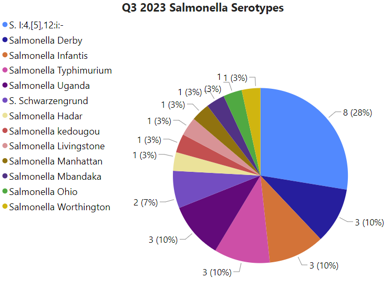 There was an overall increase in Salmonella culture detections in Q3 2023 vs Q3 2022 as well as Q3 vs Q2 2023. The majority of Q3 detections were isolated from enrichment (21/27 detections). In Q3 2023 we did see an increase variation in subtypes detected but we also had an increase in positive detections.
There was an overall increase in Salmonella culture detections in Q3 2023 vs Q3 2022 as well as Q3 vs Q2 2023. The majority of Q3 detections were isolated from enrichment (21/27 detections). In Q3 2023 we did see an increase variation in subtypes detected but we also had an increase in positive detections.
In Q3 2022, Salmonella derby was most prevalent whereas in Q3 2023 we’ve shifted more to the monophasic subtype. Within the top 5 isolated Salmonella, the serotypes have for the most part, remained similar from Q3 2022 to 2023. The Salmonella isolated from 6 cases that did not require enrichment included S. 1,4 [5],12:i:- or Monophasic (2 cases, 40 %), S. schwartengrund (1 case, 20%), S. ohio (1 case 20%), S. typhimurium (1 case, 20 %). Among the numerous detections via enrichment there was a wide representation of serotypes.
For culture detections the majority came from nursery farms and nurseries were also well represented in the herds where Salmonella was isolated by enrichment. Unfortunately, like Influenza there were quite a few instances where herd type was not specified in the demographic information from the submission form.
Laboratory Diagnostic Reports
Dr. Josepha DeLay provided an update on AHL activity in Q3 2023.
PATHOLOGY CASES
A total of 1281 swine cases, representing all test types, were submitted to the AHL during 2023 Q3. Of these, 71 cases had a pathology component (gross post-mortem and / or histopathology) and originated from commercial herds. Six (6) additional pathology cases were from pet pigs, representing a small but consistent component of AHL swine cases.
For pathology cases, the premise identification (PID) inclusion rate continues to increase (90%). Age or commodity group was provided for 100% of cases, and adequate clinical history was provided for 92% of cases. These efforts by swine practitioners are very much appreciated!
Detection of most pathogens and disease conditions remained stable during Q3, with no significant trends identified.
Interesting cases diagnosed at the AHL during 2023 Q3 are as follows:
- Pallor and jaundice were reported in sows post-farrowing. Sows were also anorexic, thin, and had poor milk production, and some sows were recumbent. CBCs identified significant regenerative anemia in most affected sows, and Mycoplasma suis was detected in pooled blood samples. Clinical findings were considered to be related to hemolytic anemia associated with M.suis.
- Nursing piglets in this same herd had diarrhea, with rotavirus and porcine sapovirus detected in feces, with high viral load (low Ct value) for both pathogens, but with no corresponding histologic lesions in intestine.
- Tracheitis was diagnosed more frequently in Q3 than in previous quarters and years. This is likely due in large part to the increased frequency of inclusion of tracheal samples among formalin-fixed tissues for histopathology. Of the 9 tracheitis cases identified in Q3, severe necrohemorrhagic tracheitis was diagnosed in 2 cases, and the etiology was undetermined. The remaining 7 cases consisted of mild lymphoplasmacytic tracheitis, which could potentially reflect background, base-level inflammation in tracheas of intensively housed pigs.
A slight downward trend continues in abortion case numbers.
Comments:
- The value of histopathology should be taken into consideration for every case in which a diagnostic workup is planned. A diagnosis is most valid when confirmed by 2 or more test methods. Including histopathology as 1 of these tests, or as supporting evidence, can dramatically strengthen the certainty of a diagnosis (‘seeing is believing’). Using histopathology samples for additional direct detection tests, such as immunohistochemistry (IHC) or in situ hybridization (ISH), can even further solidify a diagnosis. Omitting histopathology is a missed opportunity.
- Porcine sapovirus PCR is now available as an in-house test at the AHL. Increased frequency of testing for this pathogen is anticipated and this will provide a much clearer picture of the role of sapovirus in diarrhea in young swine in Ontario. In Q3, porcine sapovirus was detected with low Ct values in nursing piglets with diarrhea from a total of 4 herds (5 cases). Rotavirus was detected concurrently in cases from 3 herds.
Gallant Custom Laboratory (CEVA) Diagnostic Reports
Kevin Millsap reported on the highlights of the 6 cases submitted to Gallant Labs from Ontario in Q3 2023.
- Influenza cases increased with 4 cases of H3N2 and 2 cases of H1N2 in Q3 2023.
Other Disease Reports
Porcine Epidemic Diarrhea (PEDV)/ Porcine Deltacoronavirus (PDCoV)
Jessica Fox, manger at Swine Health Ontario (SHO) reported that there has been a slight decrease in incidence of both PED and PDCoV since the beginning of Q3.
There were 10 cases reported in Q3 2023:
County Name: Bruce (1), Grey (1), Oxford (2), Perth (3), Huron (1), Waterloo (2)
Disease Type: PED (9), PDCoV (1)
Farm Type: Finisher (10)
Jessica also reported that there have been no additional cases in Q4 2023 thus far with no new cases reported since August 31 2023. All cases are pursuing elimination.
The PED and PDCoV Tracking map is available at the Swine Health Ontario website and shows current and annual cases by county.
http://www.swinehealthontario.ca/Disease-Information/PED-PDCoV-Tracking-Map
Porcine Respiratory and Reproductive Virus (PRRS)
On the clinical impressions survey, 35.7% of practitioners that indicated that PRRS in both breeding and growing herds had increased activity in Q3 compared to Q2.
Ontario Slaughter Statistics
Federal Slaughter Statistic Summary (Q2 Aggregate)
Dr. Christine Pelland along with assistance to compile the data by Gillian Greeves reported the following:
Carcass Condemnations
- Erysipelas carcass condemnations constituted 2.7 % of all carcass condemnations. This is lower than the 7.4% recorded in Q1 2023. Absolute numbers of Erysipelas condemnations/ 100,000 inspected declined in comparison to Q1 2023 but are lower than Q2 2022. The seasonal pattern of decreased carcass condemnations due to Erysipelas in Q2 and Q3 is continuing.
- Peritonitis carcass condemnations had been steadily increasing reaching a recent peak of 78 condemnations/100,000 hogs in Q4 2022 but there has been a reduction in absolute terms with Q2 2023 at 53 condemnations/100,000 hogs inspected.
Ontario Provincial Slaughter Statistic Summary
Dr. Christine Pelland reported there were no significant changes in the causes of partial or whole carcass condemnations in Q2.
*NEW* Vet-to-Vet Column
Sometimes veterinarians filling out the quarterly clinical impression survey comment on a difficult case that they encountered or on an issue that they have yet to resolve. Moving forward we are going to use this part of the report to allow for a vet-to-vet forum for those that may want to offer suggestions or advice.
“A case of vomiting in sows that has since resolved, but with no known cause of syndrome. No other clinical signs. Occurred in lactation and continued into breeding. Sows would continue to eat but with reduced feed intake. Majority affected recovered but some sows did not. This case was ongoing for 4 months. Ruled out mycotoxins, feed particle size. Postmortems completed revealed moderate gastric ulcers and severe diffuse peritonitis, but these were sows affected for 4 weeks.”
If you have had a similar case or would like to offer vet-to-vet suggestions or advice, please send an email to Christa at: christa.Arsenault@ontario.ca.
Ontario Veterinary College Update
Dr. Zvonimir Poljak provided an update on research activities at Ontario Veterinary College:
- Interviews for candidates for the full-time academic position have been completed and the Selection Committee is getting very close to making a final decision.
- Maggie Henry is working on the development of a new tool that producers would use for emergency management that accommodates herd specific measures that can be done if the herd size needs to be reduced. The entire model is from the sale barn or from the sale population back to the different types of processing plants. Swine Health Ontario and Ontario Pork are collaborating with field testing so that any problems can be identified and corrected.
- In collaboration with AHL, a multispecies dashboard project will try to develop certain tools that can be used for forecasting and signal detection.
- Bovine and the poultry network received funding to develop unique genotyping procedures for viruses and bovine abortion. This is a much more complex type of analysis than simple PCR testing.
- Tatiana Petukawa is evaluating algorithms that can be used for PRRS prediction.
- Resources have been secured for developing zoonotic disease dashboards.
- Famke Albert’s upcoming defense on her project to predict the host species in agricultural livestock species of different influenza viruses on the basis of nuclear sequence of hemagglutinin gene. She has achieved quite promising results in terms of accuracy of this method.
- Terry O’Sullivan, in January, is planning to start a trial on a needeless injection device and will also do a pharmacokinetic study of meloxicam and iron injections.
- Vahab Farzan is carrying out studies that are looking for collecting different E coli specimens. He is asking for more participants interested in enrolling in his study.
International Disease Topics Of Interest Summary
Dr. Al Scorgie reported on some interesting international and domestic disease surveillance reports:
African Swine Fever (ASF)
Sweden: ASF detected in Sweden. On September 06th 2023, Sweden detected its’ first case of ASF in wild boars. As of September 24th, 41 cases of ASF have been found, all cases in wild boars, in Fagersta. It is a small area of 2.5 square kms. A fence enclosing 1,000 square kms has been set-up. All domestic pigs (50) on one farm in the area have been culled. Swedish authorities do not know how ASF entered the country but with the long distance the virus moved the suspicion is that human movement was responsible. Sweden has a national pig herd of 1.4 million pigs and exports 5% of its’ production. (Pig Progress, 9/25/23)
Italy: Has culled over 35,000 domestic pigs in the northern region of Lombardy since ASF first broke in 2022. So far 22 farms ranging in size from 1 to 8,800 pigs have been depopulated. The northern region is the most hog dense region in Italy. There are two areas in southern Italy where ASF has been detected and these areas currently appear “stable”. (Pig Progress,10/31/23)
Vietnam: Has approved two ASF vaccines. The Ministry of Agriculture in Vietnam has approved two ASF vaccines. NAVET-ASFVAC by Navetco Central Veterinary Medicine Company and AVAC ASF by AVAC Vietnam Joint Stock Company. The government is asking both companies to develop production plans for both domestic and export sales. The estimated cost to the producer will $1.50 (US). There are differences between the two vaccines in terms of age of administration and duration of immunity. (SHIC eNewsletter, August 2023)
Illegally imported pork recalled in U.S.
The UDSA’s Food Safety and Inspection Service, FSIS, found illegally imported pork during a routine inspection of a retail store. The products were ready-to-eat pork chicharrónes. The products were imported from Honduras. There are restrictions on the export of pork from Honduras to the U.S. because of the risk of CSF. The product did not bear a USDA mark of inspection. The products were imported into Georgia, Louisiana, Mississippi and Texas. A recall was issued, and the FSIS will conduct a recall effectiveness audit. (National Hog Farmer,9/27/23)
Surprising Discovery May Lead to Antiviral Drug to Fight PRRSV
Researchers at the University of Montreal were looking at interactions between PRRSV and other disease-causing bacteria. In one study they looked at the interaction between PRRSV and Actinobacillus pleuropneumoniae, APP. The researchers were surprised to find that when APP was present there was inhibition of PRRSV replication. Then the researchers found that the bacteria were secreting one or several molecules that have an antiviral effect. With further funding from Swine Innovation Porc (SIP) the next step will be to try to characterize these molecules. (Farmscape,7/26/23)
What are we missing with Biosecurity?
Dr. Jordan Graham from the Swine Vet Center in Minnesota recently spoke on gaps he sees in biosecurity. Many farms have clean/dirty lines, transport sanitation, shower in/out, downtime, mortality removal protocols etc. However, often these procedures and protocols are not being communicated well to both producers and staff. Dr. Graham commented that in the US industry there has been a change over the last 20 years. At one time the site owner was the one who did the chores on the site including: load-outs, washing, vaccinations and mass treatments. More and more of these tasks are being contracted out. Staff are often doing chores at multiple sites and sometimes involving multiple production systems. Dr. Graham gave the example of a crew loading market pigs at 2:00 a.m. and then going to a nursery to receive pigs at 6:00 a.m. Has anyone communicated with the crew about biosecurity expectations? Dr. Graham suggested that producers and veterinarians must understand where crews are going each day and what their responsibilities are. He also suggested that although it is an added cost it is important to have as much farm specific equipment as possible that is available at each site.
The other area Dr. Graham suggested producers focus on is on-site gilt development. Many sow farms have added both isolation and onsite gilt development. He said it can be difficult to get financing for these facilities because the output of weaners does not change. Some producers prefer purchasing gilts rather than raising them because it is more cost effective. With isolation and GDUs it can be easier to maintain stability and eliminate diseases in the sow herd. (National Hog farmer, 9/05/23)
SHIC Funds Research of Diagnostic Test Capable of Detecting Multiple Swine Viruses Simultaneously from Field samples
Through SHIC funding researchers at the University of Minnesota have developed a workflow called Target-Enriched Long-Read Sequencing of Virus, TELSVirus. This procedure can detect multiple viral pathogens from a single sample. The turnaround time for the test is 24 hours. The test can detect co-circulating viruses including porcine sapelovirus 1, porcine astrovirus 2 and 4, and porcine bocavirus as well as PRRSV, Influenza and Rotavirus. The researchers found that the limit of detection for PRRSV and Influenza is similar to qPCR. The researchers wanted to develop a test to study co-infections because co-infections are common on swine farms. Co-infections may lead to more severe disease outcomes. This test could be used to study the mutation rates of viruses, as well as the emergence or re-emergence of new viruses. Currently there has been limited research on viral co-infections. The next step will be to work with a diagnostic laboratory to apply TELSVirus in the field. (AASV News Archive 10/5/23)
Does Manure Pumping Affect the Incidence of Disease in Pigs?
Researchers at Iowa State, with funding from SHIC, the Foundation for Food and Agriculture Research and Pork Checkoff, have been studying the effect of manure pumping on the disease incidence in pigs. Besides studying the disease incidence, the researchers will look at the detection of PRRSV and PEDV in pigs and environmental surfaces before and after manure spreading in wean to-finish barns. The study is in the preliminary phase. It took place from August 2020 and December 2022. The study looked at the mortality in the two-week period after pumping manure compared to the mortality before the pumping event. Other manure pumping practices such as tank or drag hose, direct injection or airway and deep pit or lagoon were collected. The preliminary analysis of 3,000 events over 594 sites and 1,358 groups found that mortality was 21.3% lower in the two weeks after pumping in sites that transported manure in tanks than sites that used drag lines. There was no difference in mortality in sites that used direct injection or airway and sites that had deep pits or lagoons. The researchers concluded that with tanks the farther away from the pump site the manure is applied the lower the mortality. The next part of the study will be modeling that includes sites with and without disease onset and with or without exposure to pumping. (AASV News Archive, 9/14/23)
OAHN Project Update: Producer Impression Survey on Health-Related Issues
Dr. Tim Blackwell reported on an OAHN project that examined Ontario pork producers’ impressions of health-related issues on their farms. The goal was to see if there were notable differences between what the producers identified as health-related issues and the health-related issues reported by veterinarians that participate in the OAHN Veterinary Clinical Impressions survey. There were 80 producers that responded to the survey on an anonymous basis. The responses were reported for all respondents as a whole and then responses were analyzed by production categories as indicated in a very simple demographic question based on production type.
Veterinarians commonly report health problems related to PRRS and Influenza as major health concerns on farms. Although producers included PRRS and Influenza in their top health-related issues there were some issues such as lameness or postweaning scour that had higher responses as top health issues.
The survey asked “Who do you initially ask for advice on a health-related Issue”? The veterinarian was listed 57% of the time. Surprisingly, the internet did not rank very highly on this question.
The OAHN Swine Network would like to thank all of the producers that took the time to participate in this project and to fill out this survey. Veterinarians are encouraged to include some of producers top rated health issues listed above in their herd health visits and ensure that information is provided to your clients on these topics.
How can you Participate in OAHN?
Look for the 2023 Q3 veterinary clinical impression survey that will come out the first of October via an email through the OASV listserv.
The survey takes less than 10 mins time to complete!
